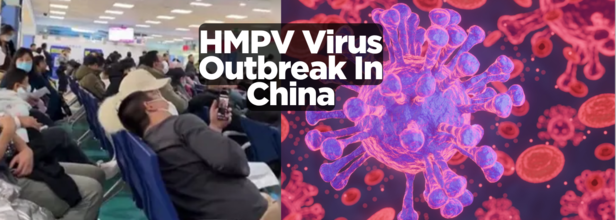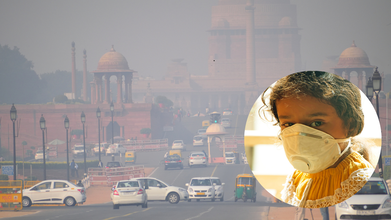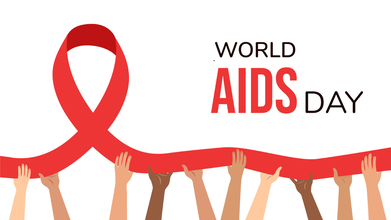- Health Conditions A-Z
- Health & Wellness
- Nutrition
- Fitness
- Health News
- Ayurveda
- Videos
- Medicine A-Z
- Parenting
New Virus Outbreak In China After COVID-19: What is HMPV? Know Symptoms And Preventive Measures

Five years after COVID-19 outbreak, China has a new health concern: the sudden outbreak of HMPV in the country. According to sources, the viral infection is growing at an exponential rate, thereby overloading health facilities and crematories, all of which could be seen online through social media posts and videos that have surfaced on the viral network. Amid these concerns, other respiratory illnesses like influenza A, Mycoplasma pneumoniae, and COVID-19 are said to be also circulating simultaneously with the same conditions, making a heavy strain on the health services. As of this, neither the Chinese government nor the WHO has given official warnings or declared any emergency in these cases.
To combat this upsurge, Chinese health authorities have implemented a pilot system to track cases of pneumonia with unknown origins. This new initiative was launched by China's disease control agency to increase preparedness for respiratory outbreaks during the winter months, a drastic change from the way the nation responded to the COVID-19 pandemic.
This outbreak has affected mostly vulnerable populations, including children whose immune systems are still developing and elderly persons who have a pre-existing respiratory disease. The symptoms of HMPV tend to be those of a cold or flu-like illness, characterized by fever, coughing, and nasal congestion. In some cases, these infections can develop into bronchitis or pneumonia, which significantly increase the risk of complications for individuals with diseases like asthma or COPD.
Despite the similarities to COVID, this virus is very different and was infact identified way back in 2001 and it has been circulating in the entire world since many years. HMPV is not a new virus, and far less worrisome.
Read for HMPV Virus Symptoms , Causes , Treatment and Prevention
What is Human Metapneumovirus (HMPV)?
First identified in the Netherlands in 2001, human metapneumovirus is a respiratory RNA virus within the Paramyxoviridae family. It is a seasonal virus, most actively circulating during the winter and spring seasons. This virus is responsible for one of the most significant causes of hospitalization in the acute respiratory infection (ARI) category among young children, after RSV.
Research indicates that almost all children older than five years have been infected with HMPV, although the immunity developed against subsequent infections is partial. Though it is more of a cold-season disease, cases have been reported throughout the year, with the prevalence of the disease fluctuating every year.
Is HMPV Contagious?
HMPV is commonly spread through contaminated respiratory droplets from infected person to person often by cough, sneeze, or the transfer of aerosolized microorganisms from touch of contaminated fingers on doorknobs and toys. Similar to RSV and influenza within the United States, HMPV follows an annual peak or surge that mostly occurs during winters and springs in many parts.
Human metapneumovirus Symptoms
HMPV infections are highly similar to some of the classic symptoms of 'common cold', they include:
- Fever
- Coughing
- Nasal congestion
- Runny nose
- Sore throat
- Nausea and vomiting
Most symptoms of bronchiolitis go away in a few days. However, more severe cases may lead to complications such as bronchitis or pneumonia, or even life-threatening conditions. Sometimes, young children may suffer from severe bronchiolitis that can be fatal.
Who Is Most at Risk?
While HMPV can affect all age groups, it significantly affects the following:
Those with immature immune systems are highly susceptible to developing severe complications like bronchiolitis or pneumonia.
Individuals with conditions such as COPD, asthma, or pulmonary fibrosis have a higher chance of developing serious symptoms.
People who are undergoing chemotherapy or have recently received an organ transplant are highly vulnerable.
Also Read: What Is Disease X? Preparing For The Next Global Threat
How Is HMPV Diagnosed and Treated?
Diagnosis of HMPV is usually based on a physical examination, patient history, and laboratory tests. In severe cases, advanced diagnostic techniques, like bronchoscopy, are applied to confirm the virus. Treatment is usually symptomatic as there are no specific antiviral therapies or vaccines for HMPV. Some treatments according to the American Lung Association include:
- Over-the-counter medications for relieving fever and pain.
- Inhalers or corticosteroids to control wheezing or harsh coughing.
- Prednisone is the prescription medication only in extreme conditions.
Human Metapneumovirus (HMPV) vs. COVID-19 HMPV and COVID-19 have similarities in their transmission modes and respiratory symptoms. HMPV is a seasonal virus, mostly surfacing during winter and spring. COVID-19, on the other hand, is a year-round virus, with emerging variants.
Surprisingly, the number of cases for other respiratory viruses, such as HMPV, rose drastically during this time as restrictions against COVID-19 relaxed. Scientific evidence shows that during the lockdowns, fewer instances of contact with regular viruses resulted in a vulnerability to them, including HMPV, after restrictions eased.
Is HMPV Preventable?
The only prevention from the virus, however is to avoid contracting it in the first place, particularly for high-risk populations. Dr. Sunil Kumar K, Lead Consultant - Interventional Pulmonology explains, "Preventive strategies include maintaining good hand hygiene, wearing masks in crowded places, and practicing respiratory etiquette, such as covering coughs and sneezes. It's also advisable to avoid close contact with individuals exhibiting respiratory symptoms. Given the absence of a vaccine, these measures are crucial in controlling the spread of the virus."
"While HMPV shares transmission characteristics with COVID-19, such as spread through respiratory droplets, it is generally less severe. However, co-circulation with other respiratory pathogens, including influenza and Mycoplasma pneumonia, as reported in China, can complicate clinical outcomes and pose additional challenges to public health systems.
Continuous surveillance and public awareness are vital in managing this outbreak. Learning from the COVID-19 pandemic, early detection, transparent communication, and adherence to preventive measures are key to mitigating the impact of HMPV and safeguarding public health."
Individuals with chronic conditions of the respiratory system should keep their environment, very clean and shy away from contaminated areas.
As respiratory illnesses continue to rise in China, health experts stress the importance of proactive measures and public awareness. While HMPV is typically mild, its potential to cause severe complications in vulnerable groups underscores the need for vigilance. For now, a combination of symptom management, robust healthcare systems, and effective monitoring initiatives will be critical in managing this growing health challenge.
Dr. Sunil Kumar K is the Lead Consultant - Interventional Pulmonology at Aster CMI Hospital, Bangalore in India
Human Metapneumovirus and Other Respiratory Viral Infections during Pregnancy and Birth, Nepal. Emerg Infect Dis. 2017
Human metapneumovirus and respiratory syncytial virus: subtle differences but comparable severity. Infect Dis Rep. 2010
Human Metapneumovirus (hMPV). American Lung Association.
Trump Offers To Release MRI Results, Admits He Is Not Sure Which Body Part Was Scanned

Credits: AP
President Donald Trump said on Sunday that he is ready to make public the results of a Magnetic Resonance Imaging (MRI) scan he underwent in October, a test that has prompted questions from political opponents and medical observers. The President also admitted he did not know which part of his body the imaging focused on.
While speaking to reporters aboard the flight back to Washington after a visit to his Mar-a-Lago residence in Florida, Trump addressed the matter of the medical report. The scan was conducted during his second physical examination of the year at Walter Reed National Military Medical Center. He said he had no objection to sharing the records and told the press, “If you want to have it released, I’ll release it.”
Trump MRI Raises Questions About Routine Testing
President Donald Trump said that he is ready to make public the results of an MRI scan he underwent in October. The White House has repeatedly maintained that his overall health remains strong. Press Secretary Karoline Leavitt has said before that the 79-year-old president received “advanced imaging” as part of his “routine physical examination,” and that the full assessment showed he stayed in “exceptional physical health.”
Still, Trump’s own remarks brought an unexpected angle to the discussion. When asked what the scan was meant to check, he described the procedure as standard. He told reporters, “Getting an MRI is very standard. What, you think I shouldn’t have it? Other people get it. I had an MRI.” He added that the findings were “perfect,” and repeated his doctors’ comment that it was “the best result he has ever seen as a doctor.”
Although he spoke with confidence about the results, he could not explain what the scan was intended to examine. “I have no idea what they analyse, but whatever they analyse, they analysed it well and they said that I had as good a result as they’ve ever seen,” he said. He did make one point clear: “It wasn’t the brain because I took a cognitive test and I aced it.”
Trump MRI Disclosure Sparks Fresh Political Debate
News of the MRI has revived debate over Trump’s willingness to share information about his health, as MRIs are not usually part of a routine annual evaluation. They are generally recommended when doctors need to study issues involving the brain, spine, or heart. The October appointment at Walter Reed followed another physical only a few months earlier and came at a time when there were reports of chronic venous insufficiency, adding to scrutiny of his health status.
Trump MRI and His Known Medical Condition
Earlier this year, the White House confirmed that Trump has chronic venous insufficiency (CVI), a vascular condition in which the veins in the legs have difficulty sending blood back to the heart. This problem can lead to swelling and discomfort.
On October 10, Trump returned to Walter Reed National Military Medical Center. Leavitt described the visit as a “routine annual check-up,” although it was his second such trip in six months. Dr. Sean Barbabella, the White House physician, did not offer details on the imaging or preventive screenings done during the appointment. He did say that the President’s laboratory reports were “exceptional,” and that his cardiac profile suggested a biological age nearly 14 years younger than his actual one.
On October 27, Trump disclosed that he had undergone an unspecified MRI during an earlier visit to Walter Reed. He said the scan produced “some of the best reports for the age” and “some of the best reports they’ve ever seen,” but the absence of further explanation has added to questions regarding his health.
Trump has also spoken before about taking the Montreal Cognitive Assessment (MoCA), a screening tool used to detect cognitive decline. He has often described it as a “very difficult IQ test.” It is not clear if another MoCA was completed during the October visit or if he was referring to the ones taken in April 2025 or January 2018.
Delhi Again Wakes Up To Toxic Air After A Brief Respite, Children Are The Worst Hit

Credits: iStock
Delhi pollution continues to worse, while yesterday their was a brief respite when the air quality index (AQI) levels were reported under the 'poor' category, and the AQI dropped to 269 at 7am on November 30. However, today, on December 1, the AQI at several stations crossed 300.
As per the Central Pollution Control Board (CPCB), Anand Vihar recorded an AQI of 325, ITO at 325, Rohini at 341, Bawana at 339, RK Puram at 336, Vivek Vihar at 321, Shadipur at 324, and Pusa at 322.
Children Are The Worst Victims Of Delhi Pollution
The toxic air in Delhi has spared no one, but the worst affected are children. On a recent weekday morning in Noida, a suburb near Delhi, BBC reported that at a crowded children’s clinic parents waited anxiously with little ones who were coughing, wheezing or struggling to breathe.
Most families said their children started falling sick in October, right when the capital’s air quality slipped into the hazardous range. This is a yearly pattern across northern India. A mix of slow winds, industrial fumes, vehicle emissions, dropping temperatures and the burning of crop residue creates a thick layer of pollution that settles over the region.
Since last month, Delhi’s Air Quality Index has mostly stayed between 300 and 400. These levels are over 20 times higher than what the World Health Organization (WHO) considers safe. Readings this high affect everyone, but young children and older adults are the most vulnerable.
Hospitals across the city have been overwhelmed with children suffering from pollution-related illnesses. Dr Shishir Bhatnagar, who heads the clinic in Noida, told BBC the number of cases has jumped sharply. He explained that young children are especially at risk because their immunity is still developing. He usually sees about 20 to 30 percent of cases linked to pollution, but that number doubles during the winter smog.
Although authorities often introduce emergency measures like halting construction or restricting vehicles, the situation has barely improved. Even an attempt at cloud seeding this year failed to bring relief, leaving millions worried about their families’ health.
For some parents, the fear is constant. BBC reports that Khushboo Bharti remembers rushing her one-year-old daughter to the hospital after a severe coughing fit left the baby vomiting and struggling to stay alert. The toddler later needed oxygen and was diagnosed with pneumonia. Other parents share similar worries, wondering whether the polluted air might cause lasting harm.
Research has repeatedly shown that prolonged exposure to polluted air can impair lung development, weaken immunity and even affect brain health. A recent study from the University of Cambridge linked certain pollutants to higher risks of dementia later in life.
While schools have postponed outdoor activities and moved younger classes online, these precautions mainly help families who have access to resources. For children living in crowded homes or near busy roads, the daily exposure is far worse. Doctors urge parents to keep children indoors when possible and use N95 masks, but many families find this unsustainable.
Parents say they feel helpless. They know children need space to play and fresh air to grow, yet every winter forces them to choose safety over normal childhood experiences.
How To Read AQI?
As per CPCB standards, here's how you can read AQI:
- 0 to 50 Good
- 51 to 100 Satisfactory
- 101 to 200 Moderate
- 201 to 300 Poor
- 301 to 400 Very Poor
- 401 to 500 Severe
World Aids Day 2025: Theme, Origin And Significance

Credits: iStock
Aids Day, a day that focuses on raising awareness on a disease that effects 40.8 million lives. In 2024 alone, 630,000 people died from AIDS-related deaths. What really is AIDS? It stands for acquired immunodeficiency syndrome, which is an advanced stage of HIV, caused by the human immunodeficiency virus. It damages the immune system so that the body is less able to fight infections and diseases.
Thus, every year, on December 1, World AIDS Day is observed to increase awareness on the same, provide support to people living with it and remember those who have lost their lives to the illness.
World Aids Day 2025: Theme
This year, the theme for Aids Day is "Rethink, Rebuild, and Rise".
The International AIDS Society (IAS) wants to create a simple message through the theme that it is important for everyone to connect and work against HIV. This is an urge to everyone from local activists to scientists, to governments, and to the global organization.
The world’s fight against HIV is entering a critical phase. Hard-won progress is under threat as political tensions grow and funding becomes uncertain. This year’s theme, “Rethink. Rebuild. Rise.” is a powerful reminder that the global community must stay united, resilient and forward-thinking to meet the challenges ahead.
Rethink calls for stronger, long-term financial planning. It urges countries to invest more of their own resources instead of relying mainly on international support.
Rebuild highlights the need to strengthen health systems, protect scientific research and support civil society groups. It also emphasizes grounding every decision in solid evidence and pushing back against misinformation.
Rise encourages the world to move ahead with a fully funded, people-centered strategy that safeguards past achievements and brings us closer to ending AIDS as a public health threat by 2030.
Importance Of World Aids Day 2025
The United Nations notes that in 2025, funding crisis is threatening the progress made in the prevention of the illness. This is why this day is a reminder for more people to connect, initiate community services that are vital for the marginalized population who are often deprioritized while the rise in punitive law criminalizes same sex relationships, gender identity, and drug use that amplifies the crisis, and makes HIV-AIDS services inaccessible.
The global response to AIDS has been shaken in recent months, and much more work is needed to meet the Sustainable Development Goal of ending AIDS by 2030. The crisis is far from over, and in today’s challenging environment, a fresh, transformative strategy is essential to reduce risks and stay on track.
World Aids Day: Origin
The day was first observed in 1988 when the World Health Organization (WHO) and the United Nations first launched it to spread awareness about HIV/AIDS, erase misconception, and build empathy for people living with AIDS. This day reminds people around the world that AIDS is not only a health problem but also a social and humanitarian issue for which everyone should work together.
Can You Prevent AIDS?
The prevention of AIDS starts from the restriction and complete stoppage of HIV. While there is no vaccine or permanent cure yet, there are ways to prevent AIDS:
- Practice Safe Sex
- Don't Share Needles
- Prevent Mother-to-child Transmission
- Ensure Safe Blood Transfusions
© 2024 Bennett, Coleman & Company Limited

